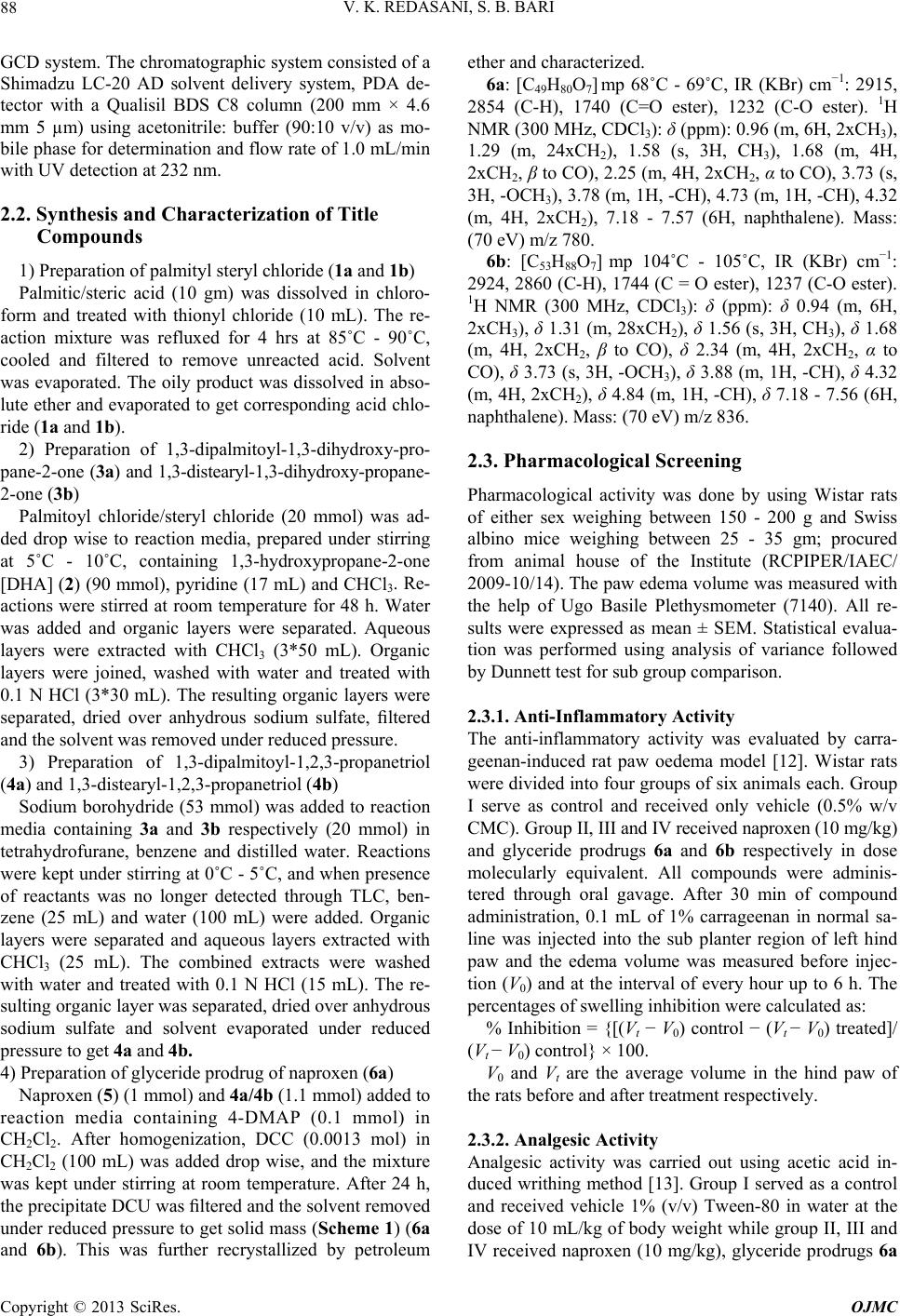
V. K. REDASANI, S. B. BARI
88
GCD system. The chromatographic system consisted of a
Shimadzu LC-20 AD solvent delivery system, PDA de-
tector with a Qualisil BDS C8 column (200 mm × 4.6
mm 5 µm) using acetonitrile: buffer (90:10 v/v) as mo-
bile phase for determination and flow rate of 1.0 mL/min
with UV detection at 232 nm.
2.2. Synthesis and Characterization of Title
Compounds
1) Preparation of palmityl steryl chloride (1a and 1b)
Palmitic/steric acid (10 gm) was dissolved in chloro-
form and treated with thionyl chloride (10 mL). The re-
action mixture was refluxed for 4 hrs at 85˚C - 90˚C,
cooled and filtered to remove unreacted acid. Solvent
was evaporated. The oily product was dissolved in abso-
lute ether and evaporated to get corresponding acid chlo-
ride (1a and 1b).
2) Preparation of 1,3-dipalmitoyl-1,3-dihydroxy-pro-
pane-2-one (3a) and 1,3-distearyl-1,3-dihydroxy-propane-
2-one (3b)
Palmitoyl chloride/steryl chloride (20 mmol) was ad-
ded drop wise to reaction media, prepared under stirring
at 5˚C - 10˚C, containing 1,3-hydroxypropane-2-one
[DHA] (2) (90 mmol), pyridine (17 mL) and CHCl3. Re-
actions were stirred at room temperature for 48 h. Water
was added and organic layers were separated. Aqueous
layers were extracted with CHCl3 (3*50 mL). Organic
layers were joined, washed with water and treated with
0.1 N HCl (3*30 mL). The resulting organic layers were
separated, dried over anhydrous sodium sulfate, filtered
and the solvent was removed under reduced pressure.
3) Preparation of 1,3-dipalmitoyl-1,2,3-propanetriol
(4a) and 1,3-distearyl-1,2,3-propanetriol (4b)
Sodium borohydride (53 mmol) was added to reaction
media containing 3a and 3b respectively (20 mmol) in
tetrahydrofurane, benzene and distilled water. Reactions
were kept under stirring at 0˚C - 5˚C, and when presence
of reactants was no longer detected through TLC, ben-
zene (25 mL) and water (100 mL) were added. Organic
layers were separated and aqueous layers extracted with
CHCl3 (25 mL). The combined extracts were washed
with water and treated with 0.1 N HCl (15 mL). The re-
sulting organic layer was separated, dried over anhydrous
sodium sulfate and solvent evaporated under reduced
pressure to get 4a and 4b.
4) Preparation of glyceride prodrug of naproxen (6a)
Naproxen (5) (1 mmol) and 4a/4b (1.1 mmol) added to
reaction media containing 4-DMAP (0.1 mmol) in
CH2Cl2. After homogenization, DCC (0.0013 mol) in
CH2Cl2 (100 mL) was added drop wise, and the mixture
was kept under stirring at room temperature. After 24 h,
the precipitate DCU was filtered and the solvent removed
under reduced pressure to get solid mass (Scheme 1) (6a
and 6b). This was further recrystallized by petroleum
ether and characterized.
6a: [C49H80O7] mp 68˚C - 69˚C, IR (KBr) cm−1: 2915,
2854 (C-H), 1740 (C=O ester), 1232 (C-O ester). 1H
NMR (300 MHz, CDCl3): δ (ppm): 0.96 (m, 6H, 2xCH3),
1.29 (m, 24xCH2), 1.58 (s, 3H, CH3), 1.68 (m, 4H,
2xCH2, β to CO), 2.25 (m, 4H, 2xCH2, α to CO), 3.73 (s,
3H, -OCH3), 3.78 (m, 1H, -CH), 4.73 (m, 1H, -CH), 4.32
(m, 4H, 2xCH2), 7.18 - 7.57 (6H, naphthalene). Mass:
(70 eV) m/z 780.
6b: [C53H88O7] mp 104˚C - 105˚C, IR (KBr) cm−1:
2924, 2860 (C-H), 1744 (C = O ester), 1237 (C-O ester).
1H NMR (300 MHz, CDCl3): δ (ppm): δ 0.94 (m, 6H,
2xCH3), δ 1.31 (m, 28xCH2), δ 1.56 (s, 3H, CH3), δ 1.68
(m, 4H, 2xCH2, β to CO), δ 2.34 (m, 4H, 2xCH2, α to
CO), δ 3.73 (s, 3H, -OCH3), δ 3.88 (m, 1H, -CH), δ 4.32
(m, 4H, 2xCH2), δ 4.84 (m, 1H, -CH), δ 7.18 - 7.56 (6H,
naphthalene). Mass: (70 eV) m/z 836.
2.3. Pharmacological Screening
Pharmacological activity was done by using Wistar rats
of either sex weighing between 150 - 200 g and Swiss
albino mice weighing between 25 - 35 gm; procured
from animal house of the Institute (RCPIPER/IAEC/
2009-10/14). The paw edema volume was measured with
the help of Ugo Basile Plethysmometer (7140). All re-
sults were expressed as mean ± SEM. Statistical evalua-
tion was performed using analysis of variance followed
by Dunnett test for sub group comparison.
2.3.1. Anti-Inflammatory Acti vi t y
The anti-inflammatory activity was evaluated by carra-
geenan-induced rat paw oedema model [12]. Wistar rats
were divided into four groups of six animals each. Group
I serve as control and received only vehicle (0.5% w/v
CMC). Group II, III and IV received naproxen (10 mg/kg)
and glyceride prodrugs 6a and 6b respectively in dose
molecularly equivalent. All compounds were adminis-
tered through oral gavage. After 30 min of compound
administration, 0.1 mL of 1% carrageenan in normal sa-
line was injected into the sub planter region of left hind
paw and the edema volume was measured before injec-
tion (V0) and at the interval of every hour up to 6 h. The
percentages of swelling inhibition were calculated as:
% Inhibition = {[(Vt − V0) control − (Vt − V0) treated]/
(Vt − V0) control} × 100.
V0 and Vt are the average volume in the hind paw of
the rats before and after treatment respectively.
2.3.2. An al gesic Acti vity
Analgesic activity was carried out using acetic acid in-
duced writhing method [13]. Group I served as a control
and received vehicle 1% (v/v) Tween-80 in water at the
dose of 10 mL/kg of body weight while group II, III and
IV received naproxen (10 m/kg), glyceride prodrugs 6a g
Copyright © 2013 SciRes. OJMC